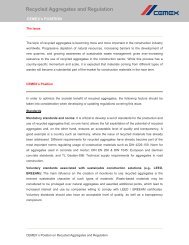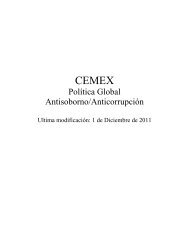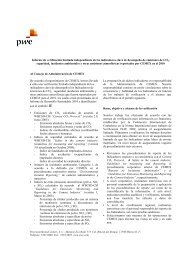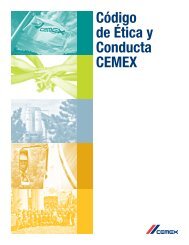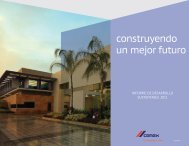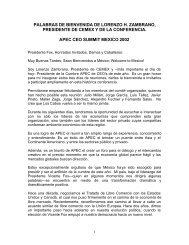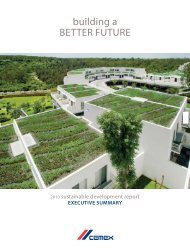building a STRONGER foundation - Cemex
building a STRONGER foundation - Cemex
building a STRONGER foundation - Cemex
You also want an ePaper? Increase the reach of your titles
YUMPU automatically turns print PDFs into web optimized ePapers that Google loves.
In 2010, as a result of our efforts, we decreased total lost-time injuries, or LTIs, for employees by 19%, achieving an LTI rate of<br />
approximately 2.6 for the year (based on a per million hours worked). Despite this improvement, 46 people, including employees,<br />
contractors and third parties, died in incidents related to our operations in 2010. We are intensifying our safety training and incident<br />
prevention measures. In 2011, we are thoroughly changing our approach to safety. Leaders at all levels of the company will be held<br />
personally accountable for improving the safety performance of their operations. In addition, we will launch a new Health and Safety<br />
Policy and implement our new Health and Safety Management System, which is aligned to Occupational Health and Safety Advisory<br />
Services 18001, and which we expect to improve our health and safety performance.<br />
The following table sets forth our performance indicators with respect to safety by geographic location for the year ended<br />
December 31, 2010:<br />
33<br />
North<br />
America Europe<br />
South America,<br />
Central and the<br />
Caribbean<br />
Africa and<br />
Middle<br />
East Asia<br />
Total<br />
CEMEX<br />
Total fatalities, employees, contractors and other third parties (#) ............... 25 4 7 7 3 46<br />
Fatalities employees (#) ................................................................................ 1 — 1 — — 2<br />
Fatality rate employees (1) ............................................................................... 0.43 — 2.36 — — 0.43<br />
Lost-Time injuries (LTI), employees (#) ...................................................... 170 50 39 5 4 268<br />
Lost-Time injuries (LTI), contractors (#)...................................................... 64 26 16 14 3 123<br />
Lost-Time injury (LTI) frequency rate, employees per million hours<br />
worked...................................................................................................... 3.1 1.7 3.6 0.9 1.1 2.6<br />
(1) Incidents per 10,000 people in a year.<br />
In conjunction with these priorities, in 2010, CEMEX was both sponsor and participant at COP16, the 16th Conference of the<br />
Parties of the United Nations Framework Convention on Climate Change. We hosted a series of events that showcased our efforts at<br />
reducing GHG emissions and protecting biodiversity, and also demonstrated the significant role ready-mix concrete can play in a lowcarbon<br />
world. Our sponsorship funds helped to offset a significant portion of the conference’s carbon emissions and support the<br />
Mexico-based Environmental Leadership for Competitiveness Program, where more than 500 small and medium size companies were<br />
benefited.<br />
We are members of the World Business Council for Sustainable Development’s Cement Sustainability Initiative and the Urban<br />
Infrastructure Initiative.<br />
Our Products<br />
We always strive to provide superior <strong>building</strong> solutions in the markets we serve. To this end, we tailor our products and services<br />
to suit customers’ specific needs, from home construction, improvement and renovation to agricultural, industrial and<br />
marine/hydraulic applications.<br />
Cement<br />
Cement is a binding agent, which, when mixed with sand, stone or other aggregates and water, produces either ready-mix<br />
concrete or mortar. Whether in bags or in bulk, we provide our customers with high-quality branded cement products and services. We<br />
tap our professional knowledge and experience to develop customized products that fulfill our clients’ specific requirements and foster<br />
sustainable construction. In many of the countries where we have cement operations, a large proportion of cement sold is a bagged,<br />
branded product. We often deliver the product to a large number of distribution outlets such that our bagged, branded cement is<br />
available to the end users in a point of sale in close proximity to where the product will be used. We strive to develop brand identity<br />
and recognition in our bagged product.<br />
We manufacture cement through a closely controlled chemical process, which begins with the mining and crushing of limestone<br />
and clay, and, in some instances, other raw materials. The clay and limestone are then pre-homogenized, a process which consists of<br />
combining different types of clay and limestone. The mix is typically dried, then fed into a grinder which grinds the various materials<br />
in preparation for the kiln. The raw materials are calcined, or processed, at a very high temperature in a kiln, to produce clinker.<br />
Clinker is the intermediate product used in the manufacture of cement. For limestone, clay and gypsum, requirements are based on<br />
chemical composition that, depending on the other materials available, matches with the quality demanded by the production process.<br />
For cement limestone, clay and gypsum, we run chemical tests to prepare the mining plan of the quarry, to confirm material quality<br />
and reduce variations in the mineral content. We consider that limestone and clay quality of our cement raw material quarries are<br />
adequate for the cement production process.



